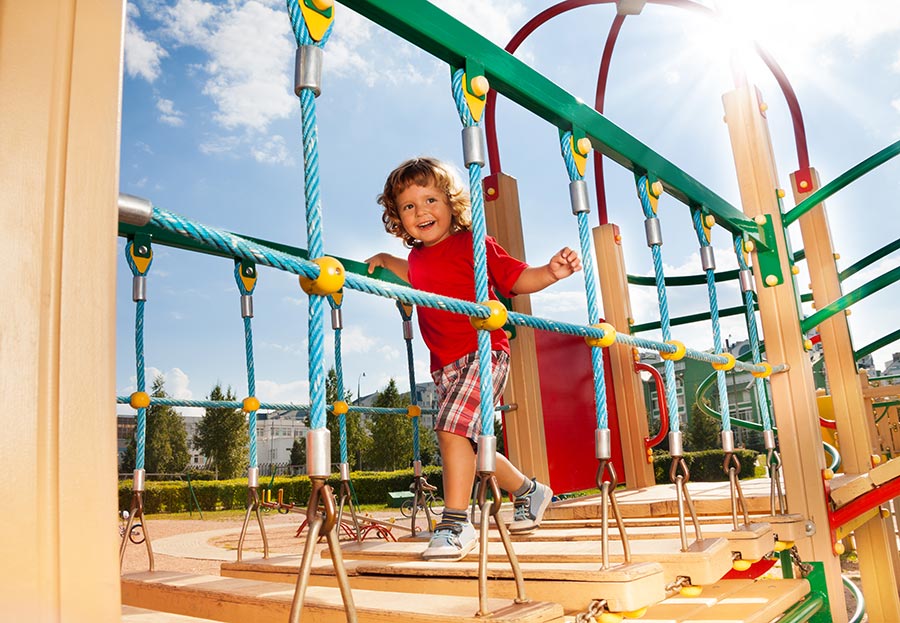Outdoor Safety
Playground Safety
- Children using playground equipment can experience many health, social and cognitive benefits.
- Although children sometimes fall from playground equipment, you can reduce the risk of injury by keeping an eye your children, encouraging the use of age-appropriate equipment and allowing them to explore creative but safe ways to move.
- Maintain a soft surface under and around all play equipment to a depth of 300mm.
Play is an important part of a child’s development. Playing outside in the fresh air can be fun and adventurous, particularly when there are playmates. However, many Australian children are less active than they should be.
Create safe play areas for children – separate play areas from driveways and roads. Young children must be within eyesight of an adult at all times while outdoors. The backyard or local playground provides lots of scope to run, climb, swing, explore and play imaginary games. With careful planning however, play environments can be challenging and safe for children.
Playground benefits for children
Being outdoors encourages all types of free play and helps children understand their environment. Playgrounds provide children with a range of experiences and opportunities including:
- being physically active
- being challenged and taking risks
- socialising with friends
- learning to cooperate
- using their imagination
- playing independently.
A well-designed playground will stimulate a child’s imagination and encourage them to explore new dimensions to play.
Playground injuries can be avoided
Almost three-quarters (70 per cent) of injuries in playgrounds are the result of falls. Most playground injuries are minor, such as scratches or bruises. However, sometimes, playground injuries result in fractures. Other rare but serious injuries include spinal and head injuries.
Climbing can be fun but the high drops might increase the risk of injury. Given their own time and space, most children will safely and gradually increase the distance they can climb. To help make landings safer, you can check to see if the ground beneath the equipment is made of loosely filled materials such as mulch or sand, rather than harder materials.
With well-thought-out planning, play environments can be made safe for children and injuries can be avoided.
Tips for protecting your child’s safety
To protect children, it is important to:
- Plan ahead for active time and aim to get children outdoors as often as possible in safe environments.
- Limit their play to equipment appropriate for their age and abilities.
- Supervise them at all times.
- Be a role model of active but sensible play and encourage them how to use the equipment creatively, but safely.
- Make sure that the children drink enough fluids. Provide water to enable children to re-hydrate after playing, or if it is particularly hot, during play.
- Modify play for a sick or injured child if they are well enough to express an interest.
- Place less emphasis on competing and more on creativity, socialising, having fun and participation.
- With the exception of the winter months, protect your child from the sun with appropriate clothes, a cap and sunscreen.
Playground equipment at home
Safety suggestions for your backyard playground include:
- Any raised platform should be made secure by a guard or handrail.
- Cover all hooks, nails or bolts.
- Rubber surfaces provide better grip than metal or wood.
- Check the equipment regularly for signs of wear and tear.
- Use mulch, river sand or other soft materials (such as rubberised surfacing) underneath the play equipment to a depth of 300 mm to offer a softer landing in case of falls.
- Consider less risky play equipment, such as a sandpit.
Safety on trampolines
Trampolines can be amazing for children’s balance, coordination and fitness. Hundreds of Australian children are taken to hospital every year for trampoline-related injuries, such as cuts, sprains and fractures. To minimise the risk of injuries from trampolines, it is important that children are supervised by an adult while playing on a trampoline.
Safety guidelines include:
- Supervise – watch children at all times, and take extra care with younger children as they are more prone to serious injury.
- Regularly check the mat and net don’t have holes, springs are intact and securely attached at both ends, frames are not bent, leg braces are locked
- Hazard-free surrounds – make sure the area around the trampoline is free from hazards like fences or garden furniture and there is an overhead clearance to avoid objects like trees and wires.
- Safety padding – always use safety padding on the frame. Cover the springs with padded mats. When buying a trampoline, look for one that meets Australian Standard AS4989-2003, a voluntary standard that requires the frame to have padding.
- Trampolines are not suitable for children under six years of age. Consider the trampoline as sports equipment, not a toy.
- Make sure the trampoline is in good order and replace worn parts promptly. If the trampoline is outside and exposed to sun and rain, check regularly for signs of rusting and other damage.
- Sink the trampoline into the ground for greater stability; this also provides a lower fall height.
- Drinking or eating while bouncing should not be allowed because of the possibility of choking on food.
- Bare feet provide better grip.
- Make sure there is only one child at a time on the trampoline.
- Encourage and remind the child to jump in the centre, not near the sides.
- Teach the child to get on and off the trampoline slowly and safely.
- Clear the area around the trampoline of any obstacles, toys and debris.
Local council playgrounds
Equipment in a public playground generally caters for children of all ages. Your child might be at risk of injury from a piece of equipment designed for older children. Safety tips include:
- Make sure your child only uses equipment that is appropriate for their age, strength and coordination.
- Remind your child to be aware of other children playing, particularly near swings or other moving pieces of equipment.
- Contact your local council if the equipment needs repair or maintenance work.
Things to remember
- Children using playground equipment can experience many health, social and cognitive benefits.
- Although children sometimes fall from playground equipment, you can reduce the risk of injury by keeping an eye your children, encouraging the use of age-appropriate equipment and allowing them to explore creative but safe ways to move.
- Maintain a soft surface under and around all play equipment to a depth of 300mm.





